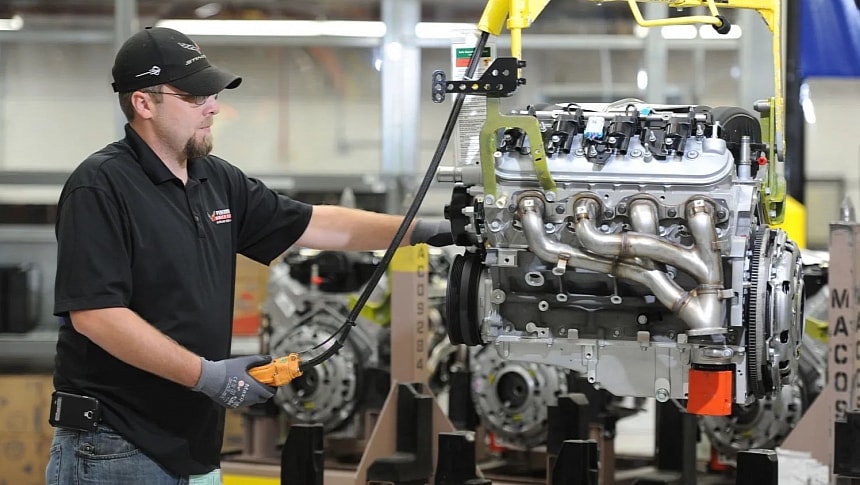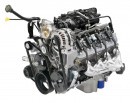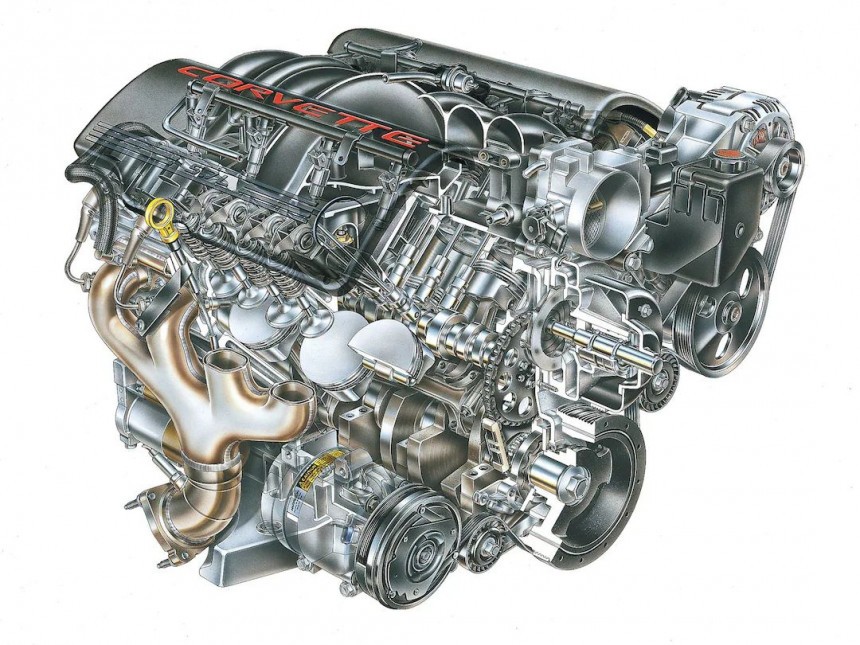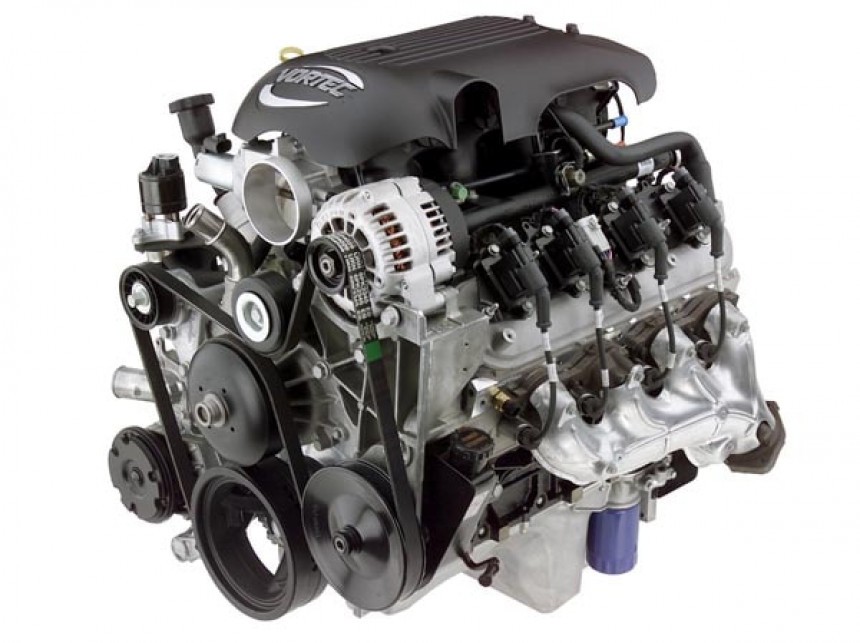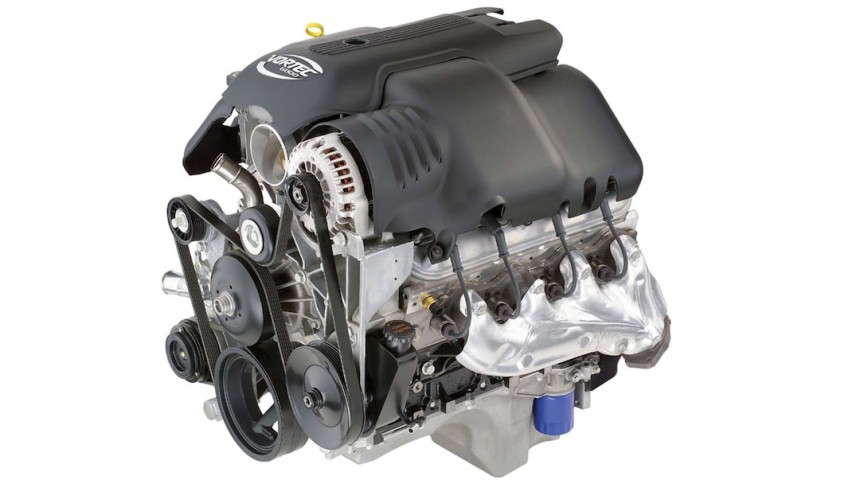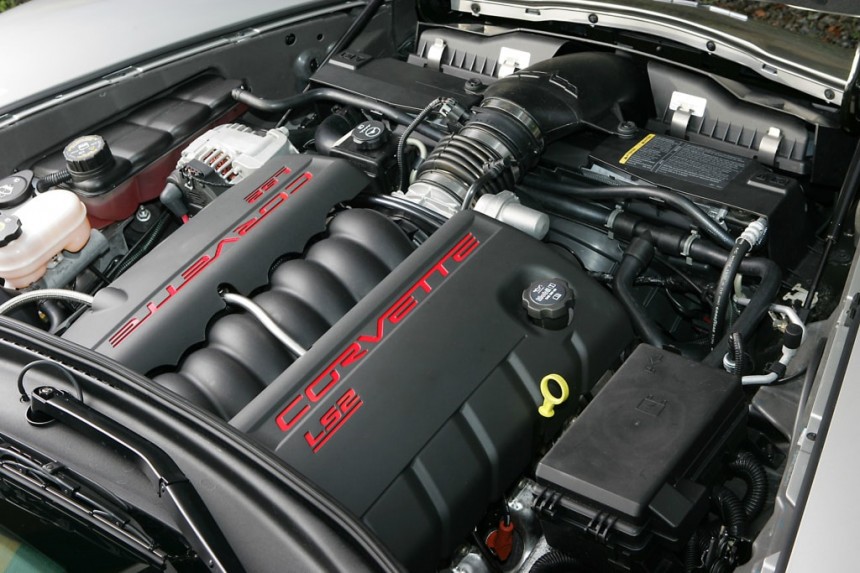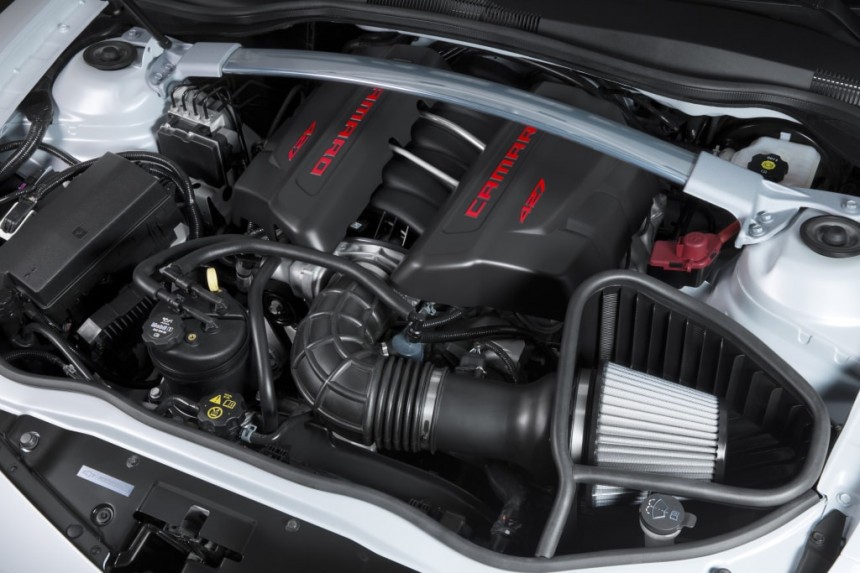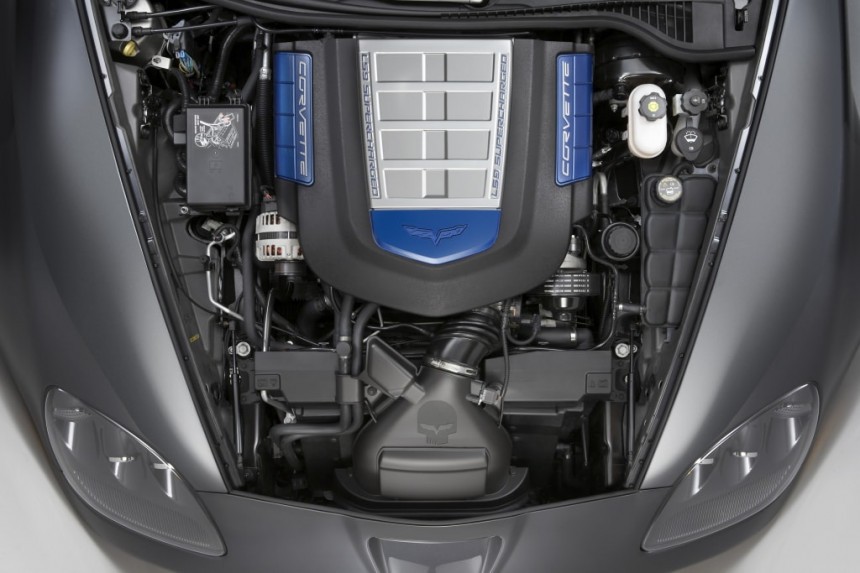An endangered species due to increasingly stringent fuel economy and emission regulations, the Chevy small-block V8 rolled out in 1964 with a displacement of 265 cubic inches in the C1 Corvette. If you prefer the metric system, that would be 4.3 liters. After two generations, the universally eulogized SBC leveled up to the LS architecture in 1997, starting with the LS1 of the C5 Corvette.
Tremendously different from the Gen 2 small block from the early 1990s, the Gen 3 is referred to as the LS after the aforementioned progenitor. A highly modular design, the LS was replaced by the LT in 2013. The newcomer is a fifth-gen small block, and the primary upgrade over the LS comes in the form of direct fuel injection (or direct and port fuel injection for the LT5 of the C7 Corvette ZR1).
The LT, however, is a story for another time. Both the third- and fourth-gen families are called LS because of their similarities. Generation IV builds on Generation III with displacement on demand and variable valve timing, as well as provisions for higher displacements. As opposed to a maximum of 6.0 liters for the Generation III small-block V8, the successor was taken to 7.0 liters in the C6 Corvette Z06 and 2014 Camaro Z/28.
Before going any further with each bore family of the Generation III and Generation IV small block, it should be noted that LSX isn't the same thing as LSx. The uppercase X indicates a GM Performance Parts crate engine (think LSX454), whereas the lowercase x is a substitute for a number. Otherwise put, LSx stands for series-production LS engine.
Generation III small-block V8s
LS1 is the regular production order code of the first-ever LS, which pushed out 345 horsepower and 350 pound-feet (475 Nm) of torque in the 1997 Corvette. The aluminum block makes the LS1 approximately 100 pounds (45 kilograms) lighter than its cast-iron predecessor, but do bear in mind that certain Generation III and Generation IV also feature iron blocks. The cast-iron blocks in question were used exclusively in trucks, body-on-frame SUVs, and large vans from Chevrolet and GMC.
The LS1 was used in series-production applications through 2005, its final applications being the Aussie-built Holden Monaro and Holden Statesman. Although its regular production code is shared with a 454-ci big block from the 1970s and the Iron Duke four-pot engine, LS6 is best described as the LS1's punchier sibling. From a similar displacement, it makes up to 405 horsepower and 400 pound-feet (542 Nm) in the C5 Corvette Z06.
The 2004 model year Cadillac CTS-V also came with said lump in combination with a Tremec-supplied manual transmission. Formerly known as Shelby SuperCars, the folks at SSC North America used the LS6 in the SSC Ultimate Aero TT. Timed at 256 miles per hour (412 kilometers per hour) back in 2007, the mid-engine sensation was rated at 1,180 horsepower and the kind of peak torque that would make a heavy-duty turbo diesel truck blush in awe. Its heavily modified LS6 was bored out from the original 5.7 to 6.3 liters and – as implied by the TT suffix – gained a couple of turbos.
3.78 inches bore multiplied by 3.27 inches for the stroke means 4.8 liters for the LR4. The smallest member of the Generation III small-block V8 engine family, the LR4 was branded Vortec 4800. Specifically designed for truck applications, the 3.78-inch series also gave us the Vortec 5300, which came in a variety of specifications.
0.35 more inches of stroke resulted in a wee bit more power and – even more importantly – more torque for the 5300. General Motors also made an aluminum-alloy Vortec 5300 for a brief period, with said mill dubbed L33 in the ordering system.
3.78s offered up to 335 pound-feet (454 Nm) on regular gas. Only the L59 is compatible with E85 flex fuel, a blend of gasoline and ethanol containing anything between 51 and 83 percent ethanol. Corn brew is also the secret to the Dodge Challenger SRT Demon 170's absurdly powerful Hellcat HEMI V8, an iron-block masterpiece that puts out 1,025 hp and 945 lb-ft (1,281 Nm) with E85 in the tank.
The largest Generation III small blocks of them all, the LQ4 and LQ9 are cast-iron workhorses. GM advertised them as the Vortec 6000, with the LQ9 being the performance-oriented version. Produced in Romulus, Michigan, the LQ9 was renamed from Vortec HO 6000 to VortecMAX in 2006.
LQ9 powered the Cadillac Escalade from 2002 through 2006. The Chevrolet and GMC divisions received the go-faster engine in 2003 and 2004, respectively, with notable applications that include the Silverado SS and the Sierra HO Edition.
High-compression pistons help the LQ9 develop 20 more horsepower. LQ4s range between 300 and 325 ponies, whereas the LQ9 is rated at 345 ponies. LQ9-engined pickup trucks and sport utility vehicles came with a 4.10:1 rear axle ratio.
Generation IV small-block V8s
LS2 followed the LS1 as the first member of the Generation IV small-block V8 engine family. Not surprising in the least, GM debuted this powerplant in the Chevrolet division's halo sports car. The Corvette-twinned Cadillac XLR used the notoriously problematic Northstar V8. As it happens, the head gasket bolts of the 1995 to 2005 Northstar 4.6-liter V8 tend to loosen in their threads over time, resulting in blown head gaskets.
The L76 is the more economical brother of the LS2, for it brings Active Fuel Management to the table. In both eight- and six-cylinder applications, AFM disables half of the cylinders in light-load conditions. Active Fuel Management was replaced by Dynamic Fuel Management in the 5.3-liter L84 and 6.2-liter L87 fifth-gen small blocks. DFM alternates between a grand total of 17 firing orders and can even run the engine using one cylinder.
L98 makes do without the L76's fuel-sipping technology. The L77 has flex-fuel capability, whereas the LY6 replaced the LQ4 in heavy-duty trucks, the Chevrolet Express, and GMC Savanna. The LY6-replacing L96 added E85 capability. Last but not least, LFA and LZ1 are Gen IV small-block V8s developed for hybrid pickup trucks and sport utility vehicles based on the GMT900 platform.
In a similar fashion to the previous generation's 3.78-inch bore blocks, General Motors developed a variety of 4.8- and 5.3-liter V8s for a variety of vehicles. The most intriguing of the bunch is the LS4 for transverse FWD cars such as the Pontiac Grand Prix GXP, Chevrolet Impala SS, Monte Carlo SS, as well as the Buick LaCrosse Super.
The biggest automaker of the Detroit Big Three had to shorten the crankshaft at the accessory drive and flywheel ends. General Motors opted for a single serpentine belt for all the accessories due to very limited space. So limited that the water pump is mounted remotely. The LS4 uses an aluminum block, and the same can be said about the LH6 and LC9 for rear-biased trucks and SUVs. The LY5, LMG, LH8, LH9, and LMF are cast-iron blocks.
LY2 and L20 are both Vortec 4800 engines, the main difference between them being variable valve timing for the latter. The LY2 was used for 2007 through 2009 model year vehicles, while the more powerful L20 was offered through 2017 in the Chevrolet Express and GMC Savana large vans.
Closely related to the LS427 crate engine, the series-production LS7 wouldn't have been possible without the 427-cube Katech LS1.R of the Chevrolet Corvette C5-R endurance racing car. It's the largest and most powerful SBC ever intended for street-legal applications. Believe it or not, the Vertical Hummingbird 300LS helicopter uses a derated version of this motorsport-inspired V8.
The LS7 premiered for the 2006 model year in the C6 Corvette Z06. Three other nameplates received the 7.0-liter colossus, those nameplates being the 2013 Chevrolet Corvette 427 Convertible, 2014 Chevrolet Camaro Z/28, and the Holden VE Commodore-based HSV W427 for Australia. 137 units were produced in total, making the HSV W427 rarer than the Corvette 427 Convertible.
In the Z06 and 427 convertible, said engine makes a hugely respectable 505 horsepower and 470 pound-feet (637 Nm). Camaro Z/28 spices things up with 11 more pound-feet (652 Nm). Also worthy of note, the Camaro Z/28 is the first Camaro with a dry-sump lubrication system. The sixth-gen Camaro ZL1, by comparison, uses a wet-sump LT4 as opposed to the Corvette's dry-sump LT4.
The Generation IV 4.06-inch bore blocks can be split into two categories. Full-size trucks and SUVs used the Vortec 6200-branded L92, L9H, and L94, whereas the remainder powered the Corvette, Camaro, CTS-V, and a handful of other cars from the GM portfolio. The Pontiac G8 GXP comes to mind, as do the Vauxhall VXR8, VXR8 GTS, VXR8 GTS-R, HSV GTS GEN-F, and GTSR W1.
As you're well aware, HSV and Holden are no longer among us. Vauxhall soldiers on with sister brand Opel in the Old Continent, albeit under the Stellantis umbrella. Although the LS3 remains LS royalty, the most powerful small-block V8s from this generation are the LSA and LS9 thanks to supercharging. The blowers displace 1.9 and 2.3 liters, respectively.
It goes without saying that both require 93-octane dinosaur juice in order to make their advertised ratings. At the time, the C6-generation ZR1 was the most powerful and torquiest 'Vette of them all, packing 638 horsepower and 604 pound-feet (819 Nm). The Generation V LT5 in the C7 Corvette ZR1 cranks out a ridiculous 755 horsepower and 715 pound-feet (969 Nm) due to dual injection and a 2.65-liter Eaton TVS blower, making it the most powerful and torquiest small-block V8 ever.
The LT, however, is a story for another time. Both the third- and fourth-gen families are called LS because of their similarities. Generation IV builds on Generation III with displacement on demand and variable valve timing, as well as provisions for higher displacements. As opposed to a maximum of 6.0 liters for the Generation III small-block V8, the successor was taken to 7.0 liters in the C6 Corvette Z06 and 2014 Camaro Z/28.
Before going any further with each bore family of the Generation III and Generation IV small block, it should be noted that LSX isn't the same thing as LSx. The uppercase X indicates a GM Performance Parts crate engine (think LSX454), whereas the lowercase x is a substitute for a number. Otherwise put, LSx stands for series-production LS engine.
Generation III small-block V8s
3.898-inch bore blocks: LS1 and LS6
The LS1 was used in series-production applications through 2005, its final applications being the Aussie-built Holden Monaro and Holden Statesman. Although its regular production code is shared with a 454-ci big block from the 1970s and the Iron Duke four-pot engine, LS6 is best described as the LS1's punchier sibling. From a similar displacement, it makes up to 405 horsepower and 400 pound-feet (542 Nm) in the C5 Corvette Z06.
The 2004 model year Cadillac CTS-V also came with said lump in combination with a Tremec-supplied manual transmission. Formerly known as Shelby SuperCars, the folks at SSC North America used the LS6 in the SSC Ultimate Aero TT. Timed at 256 miles per hour (412 kilometers per hour) back in 2007, the mid-engine sensation was rated at 1,180 horsepower and the kind of peak torque that would make a heavy-duty turbo diesel truck blush in awe. Its heavily modified LS6 was bored out from the original 5.7 to 6.3 liters and – as implied by the TT suffix – gained a couple of turbos.
3.78-inch bore blocks: LR4, LM7, L59, LM4, L33
0.35 more inches of stroke resulted in a wee bit more power and – even more importantly – more torque for the 5300. General Motors also made an aluminum-alloy Vortec 5300 for a brief period, with said mill dubbed L33 in the ordering system.
3.78s offered up to 335 pound-feet (454 Nm) on regular gas. Only the L59 is compatible with E85 flex fuel, a blend of gasoline and ethanol containing anything between 51 and 83 percent ethanol. Corn brew is also the secret to the Dodge Challenger SRT Demon 170's absurdly powerful Hellcat HEMI V8, an iron-block masterpiece that puts out 1,025 hp and 945 lb-ft (1,281 Nm) with E85 in the tank.
4.00-inch bore blocks: LQ4 and LQ9
LQ9 powered the Cadillac Escalade from 2002 through 2006. The Chevrolet and GMC divisions received the go-faster engine in 2003 and 2004, respectively, with notable applications that include the Silverado SS and the Sierra HO Edition.
High-compression pistons help the LQ9 develop 20 more horsepower. LQ4s range between 300 and 325 ponies, whereas the LQ9 is rated at 345 ponies. LQ9-engined pickup trucks and sport utility vehicles came with a 4.10:1 rear axle ratio.
Generation IV small-block V8s
4.00-inch bore blocks: LS2, L76, L98, L77, LY6, L96, LFA, LZ1
The L76 is the more economical brother of the LS2, for it brings Active Fuel Management to the table. In both eight- and six-cylinder applications, AFM disables half of the cylinders in light-load conditions. Active Fuel Management was replaced by Dynamic Fuel Management in the 5.3-liter L84 and 6.2-liter L87 fifth-gen small blocks. DFM alternates between a grand total of 17 firing orders and can even run the engine using one cylinder.
L98 makes do without the L76's fuel-sipping technology. The L77 has flex-fuel capability, whereas the LY6 replaced the LQ4 in heavy-duty trucks, the Chevrolet Express, and GMC Savanna. The LY6-replacing L96 added E85 capability. Last but not least, LFA and LZ1 are Gen IV small-block V8s developed for hybrid pickup trucks and sport utility vehicles based on the GMT900 platform.
3.78-inch bore blocks: LY2, L20, LH6, LS4, LY5, LC9, LMG, LH8, LH9, LMF
The biggest automaker of the Detroit Big Three had to shorten the crankshaft at the accessory drive and flywheel ends. General Motors opted for a single serpentine belt for all the accessories due to very limited space. So limited that the water pump is mounted remotely. The LS4 uses an aluminum block, and the same can be said about the LH6 and LC9 for rear-biased trucks and SUVs. The LY5, LMG, LH8, LH9, and LMF are cast-iron blocks.
LY2 and L20 are both Vortec 4800 engines, the main difference between them being variable valve timing for the latter. The LY2 was used for 2007 through 2009 model year vehicles, while the more powerful L20 was offered through 2017 in the Chevrolet Express and GMC Savana large vans.
4.125-inch bore blocks: LS7
The LS7 premiered for the 2006 model year in the C6 Corvette Z06. Three other nameplates received the 7.0-liter colossus, those nameplates being the 2013 Chevrolet Corvette 427 Convertible, 2014 Chevrolet Camaro Z/28, and the Holden VE Commodore-based HSV W427 for Australia. 137 units were produced in total, making the HSV W427 rarer than the Corvette 427 Convertible.
In the Z06 and 427 convertible, said engine makes a hugely respectable 505 horsepower and 470 pound-feet (637 Nm). Camaro Z/28 spices things up with 11 more pound-feet (652 Nm). Also worthy of note, the Camaro Z/28 is the first Camaro with a dry-sump lubrication system. The sixth-gen Camaro ZL1, by comparison, uses a wet-sump LT4 as opposed to the Corvette's dry-sump LT4.
4.06-inch bore blocks: LS3, L99, LS9, LSA, L92, L9H, L94
As you're well aware, HSV and Holden are no longer among us. Vauxhall soldiers on with sister brand Opel in the Old Continent, albeit under the Stellantis umbrella. Although the LS3 remains LS royalty, the most powerful small-block V8s from this generation are the LSA and LS9 thanks to supercharging. The blowers displace 1.9 and 2.3 liters, respectively.
It goes without saying that both require 93-octane dinosaur juice in order to make their advertised ratings. At the time, the C6-generation ZR1 was the most powerful and torquiest 'Vette of them all, packing 638 horsepower and 604 pound-feet (819 Nm). The Generation V LT5 in the C7 Corvette ZR1 cranks out a ridiculous 755 horsepower and 715 pound-feet (969 Nm) due to dual injection and a 2.65-liter Eaton TVS blower, making it the most powerful and torquiest small-block V8 ever.
